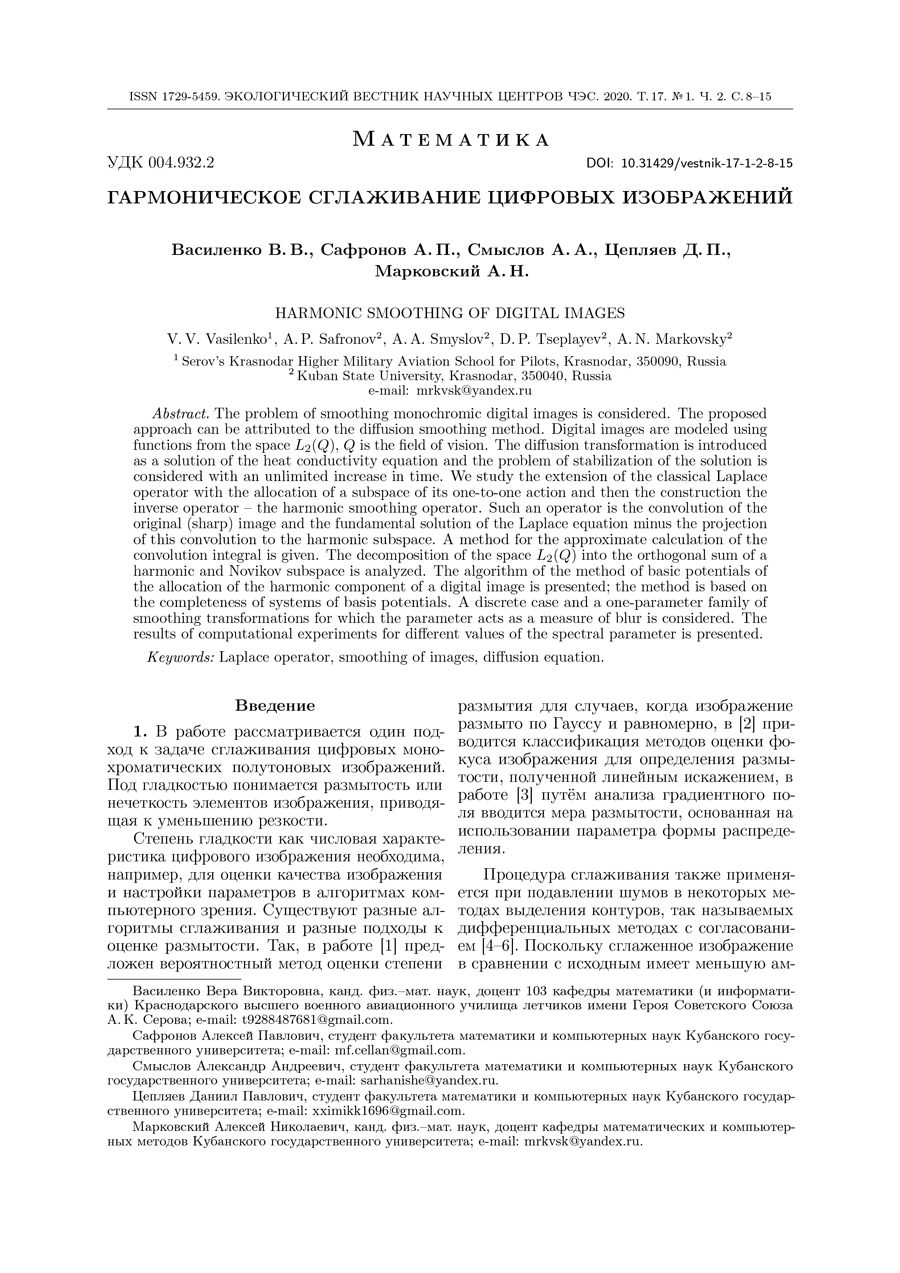Harmonic Smoothing of Digital Images
UDC
004.932.2DOI:
https://doi.org/10.31429/vestnik-17-1-2-8-15Abstract
The problem of smoothing monochromic digital images is considered. The proposed approach can be attributed to the diffusion smoothing method. Digital images are modeled using functions from the space $L_{2}(Q)$, $Q$ is the field of vision. The diffusion transformation is introduced as a solution of the heat conductivity equation and the problem of stabilization of the solution is considered with an unlimited increase in time. We study the extension of the classical Laplace operator with the allocation of a subspace of its one-to-one action and then the construction the inverse operator - the harmonic smoothing operator. Such an operator is the convolution of the original (sharp) image and the fundamental solution of the Laplace equation minus the projection of this convolution to the harmonic subspace. A method for the approximate calculation of the convolution integral is given. The decomposition of the space $L_{2}(Q)$ into the orthogonal sum of a harmonic and Novikov subspace is analyzed. The algorithm of the method of basic potentials of the allocation of the harmonic component of a digital image is presented; the method is based on the completeness of systems of basis potentials. A discrete case and a one-parameter family of smoothing transformations for which the parameter acts as a measure of blur is considered. The results of computational experiments for different values of the spectral parameter is presented.
Keywords:
Laplace operator, smoothing of images, diffusion equationReferences
- Kol'tsov, P.P. Otsenka razmytiya izobrazheniya [Assessment of image blur]. Komp'yuternaya optika [Computer optics], 2011, vol. 31, no. 1, pp. 95–102. (In Russian)
- Ronzhin, A.L., Vatamanyuk, I.V., Ronzhin, A.L. et al. Mathematical methods to estimate image blur and recognize faces in the system of automatic conference participant registration. Automation and Remote Control, 2015, vol. 76, pp. 2011–2020.
- Asatryan, D.G. Otsenivanie stepeni razmytosti izobrazheniya putem analiza gradientnogo polya [Estimating the degree of image blur by analyzing a gradient field]. Komp'yuternaya optika [Computer Optics], 2017, vol. 41, no. 6, pp. 957–962. (In Russian)
- Soyfer, V.A. (ed.) Metody komp'yuternoy obrabotki izobrazheniy [Computer image processing methods]. Fizmatlit, Moscow, 2003. (In Russian)
- Gonsales, R., Vuds, R. Tsifrovaya obrabotka izobrazheniy [Digital image processing]. Tekhnosfera, Moscow, 2012. (In Russian)
- Sizikov, V.S. Pryamye i obratnye zadachi vosstanovleniya izobrazheniy, spektroskopii i tomografii s MatLab [Direct and inverse problems of image restoration, spectroscopy and tomography with MatLab]. Lan', Moscow, 2017. (In Russian)
- Mikhaylov, V.P. Differentsial'nye uravneniya v chastnykh proizvodnykh [Partial Differential Equations]. Nauka, Moscow, 1987. (In Russian)
- Lezhnev, V.G., Markovskiy, A.N. Pryamaya i obratnaya kraevye zadachi uravneniya rasprostraneniya neizotropnoy diffuzii [Direct and inverse boundary value problems of the distribution equation of non-isotropic diffusion]. Ekologicheskiy vestnik nauchnykh tsentrov Chernomorskogo ekonomicheskogo sotrudnichestva [Ecological Bulletin of the Scientific Centers of the Black Sea Economic Cooperation], 2005, no. 3, pp. 28–33. (In Russian)
- Borisenko, G.V., Denisov, A.M. Nonlinear source in diffusion filtering methods for image processing. Comput. Math. and Math. Phys., 2007, vol. 47, pp. 1631–1635.
- Rossovskii, L.E. Image filtering with the use of anisotropic diffusion. Comput. Math. and Math. Phys., 2017, vol. 57, pp. 401–408.
- Shonin, I.S. Primenenie anizotropnogo fil'tra Perona–Malika v zadache raspoznavaniya posadochnoy ploshchadki [The use of the Peron-Malika anisotropic filter in the recognition of the landing site]. Vestnik Kontserna VKO "Almaz-Antey" [Bulletin of the Concern "Almaz-Antey"], 2017, vol. 1, no. 20, pp. 82–87. (In Russian)
- Popova, G.M., Stepanov, V.N. Examination and Processing of the Images of Biomedical Microobjects. Automation and Remote Control, 2004, vol. 65, pp. 116–126.
- Gaydel', A.V., Krasheninnikov, V.R. Otbor priznakov dlya zadachi diagnostiki osteoporoza po rentgenovskim izobrazheniyam sheyki bedra [Selection of signs for the diagnosis of osteoporosis using x-ray images of the femoral neck]. Komp'yuternaya optika [Computer optics], 2016, vol. 40, no. 6, pp. 939–946. (In Russian)
- Khryashchev, D.A. Ob odnom metode vydeleniya konturov na tsifrovykh izobrazheniyakh [About one method of selecting contours in digital images]. Vestnik Astrakhanskogo gosudarstvennogo tekhnicheskogo universiteta. Seriya "Upravlenie. Vychislitel'naya tekhnika. Informatika" [Bulletin of the Astrakhan State Technical University. Series "Management. Computer engineering. Informatics"], 2010, vol. 2, pp. 181–187. (In Russian)
- Yagola, A.G., Koshev, N.A. Vosstanovlenie smazannykh i defokusirovannykh tsvetnykh izobrazheniy [Recovery of blurry and defocused color images]. Vychislitel'nye metody i programmirovanie [Computational methods and programming], 2008, vol. 9, no. 3, pp. 207–212. (In Russian)
- Serezhnikova, T.I. Ustoychivye metody vosstanovleniya zashumlennykh izobrazheniy [Sustainable methods for restoring noisy images]. Vestnik YuUrGU. Seriya Matematicheskoe modelirovanie i programmirovanie [Bulletin of the South Ural State University. Series "Mathematical Modeling and Programming"], 2011, no. 25, pp. 32–42. (In Russian)
- Lezhnev, A.V., Lezhnev, V.G. Metod bazisnykh potentsialov v zadachakh matematicheskoy fiziki i gidrodinamiki [The method of basic potentials in problems of mathematical physics and hydrodynamics]. Kuban State University, Krasnodar, 2009. (In Russian)
- Vasilenko, V.V. Matematicheskie algoritmy analiza tsifrovykh izobrazheniy [Mathematical algorithms for the analysis of digital images]. Abstract. of dis. \ldots cand. Phys.-Math. of sciences. Stavropol, 2006. (In Russian)
Downloads
Submitted
Published
How to Cite
Copyright (c) 2020 Vasilenko V.V., Safronov A.P., Smyslov A.A., Tseplayev D.P., Markovsky A.N.

This work is licensed under a Creative Commons Attribution 4.0 International License.




